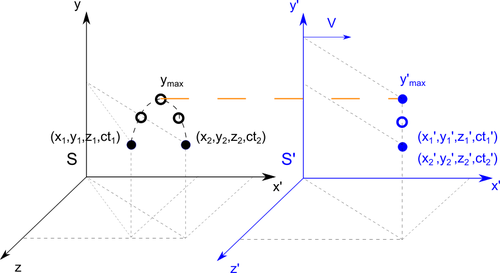Albert Einstein
14 March 1879 – 18 April 1955
Creator of: Special Relativity Theory
Time dilatation

Let's say we have two systems \(S\) and \(S'\). The system \(S'\) is moving at a speed \(\vec{v}_{x}\)
in relation to the system \(S\). Observer in the each systems is going to define position of the moving object.
Object in \(S'\) system is moving up and then is falls down. The starting position is
\((x'_{1}, y'_{1}, z'_{1}, ct'_{1})\), after object get to the maximum top position
\(y'_{max}\) he falls down to the end position \((x'_{2}, y'_{2}, z'_{2}, ct'_{2})\).
From system \(S\) perspective starting and ending position is set by
Lorentz transformation:
\begin{equation} x_{1} = \frac{x_{1}' + \vec{v}t_{1}'}{\sqrt{1-\frac{v^{2}}{c^{2}}}} \quad x_{2} =
\frac{x_{2}' + \vec{v}t_{2}'}{\sqrt{1-\frac{v^{2}}{c^{2}}}} \end{equation}
Taking into account the sequence of events:
$$ t_{2}' > t_{1}'$$
From here we get:
$$ x_{2}' > x_{1}'$$
This result is interpreted as from \(S\) system observer see object
going up in place \(x_{1}\) and falling dow in another place \(x_{2}\),what is show on
the picture.
When is going to time of the events, they transform according to
Lorentz transformation:
\begin{equation} t_{1} = \frac{t_{1}' + x_{1}'\frac{\vec{v}}{c^{2}}}{\sqrt{1-\frac{v^{2}}{c^{2}}}} \quad
t_{2} = \frac{t_{2}' + x_{2}'\frac{\vec{v}}{c^{2}}}{\sqrt{1-\frac{v^{2}}{c^{2}}}} \end{equation}
To compare durations of the event in both systems we simply subtract
time \(t_{2}\) from time \(t_{1}\):
$$ \Delta t = t_{2} - t_{1} = \frac{t_{2}' + x_{2}'\frac{\vec{v}}{c^{2}} - t_{1}' - x_{1}'\frac{\vec{v}}{c^{2}}}{\sqrt{1-\frac{v^{2}}{c^{2}}}}$$
After reduction we finally get equation for time dilatation:
\begin{equation} \Delta t = \frac{t_{2}' - t_{1}'}{\sqrt{1-\frac{v^{2}}{c^{2}}}} = \frac{\Delta t'}{\sqrt{1-\frac{v^{2}}{c^{2}}}}\end{equation}
Time dilatation example
Let say you stand next to the road observing autos. After one of them
is passing you with speed of 120 km/h you have been wondering how much time those
people save. In this case you staying in \(S\) system, and the people are moving with
car in the \(S'\) system. Now we will compare flow of time in your surroundings \(t\)
and in the car surroundings \(t'\):
$$\vec{v} = 120 \frac{km}{h} = \frac{1}{30} \frac{km}{s} \quad ; \quad c = 3 \cdot 10^{5} \frac{km}{s}$$
$$ \Delta t = \frac{\Delta t'}{\sqrt{1-\frac{(\frac{1}{30})^{2}}{(3 \cdot 10^{5})^{2}}}} =
\frac{\Delta t'}{\sqrt{1-\frac{1}{81} \cdot 10^{-12}}} \approx \frac{\Delta t'}{0.9999999999999938}$$
$$ \Rightarrow \Delta t > \Delta t' $$
The score says that your time is flowing faster than for people in
car. If you spend entire life (80 years) in car moving with speed 100 km/h, then you
save amount of time equals to:
$$ \Delta t' = 80 years = 2522880000 s \Rightarrow \Delta t = 2522880000.0000157 s$$
$$saved \quad time = \Delta t - \Delta t' = 0.0000157 s $$
Like you see this it's almost nothing. To make difference you need
to move with a fraction of the speed of light. Let's assume that you are moving with
half of light speed (0.5c). In this case to simplicity our calculations
we set speed of light equals to 1 (c = 1). Then you save much more time:
$$ \Delta t = \frac{\Delta t'}{\sqrt{1-\frac{(\frac{1}{2})^{2}}{(1)^{2}}}} =
\frac{\Delta t'}{\sqrt{1-\frac{1}{4}}} = \Delta t' \cdot \frac{2}{\sqrt{3}}$$
When we again are moving with this speed for 80 years then we save time equals to:
$$ \Delta t' = 80 years = 2522880000 s \Rightarrow \Delta t = 2913170894.2662463 s$$
$$saved \quad time = \Delta t - \Delta t' = 390290894.2662463s \approx 12.4 years $$
That means when we go back from space mowing with 0.5 speed of light
to earth, then we will have 80 years but people on earth will be 92.4 years old. This
is the real travel to the future!
